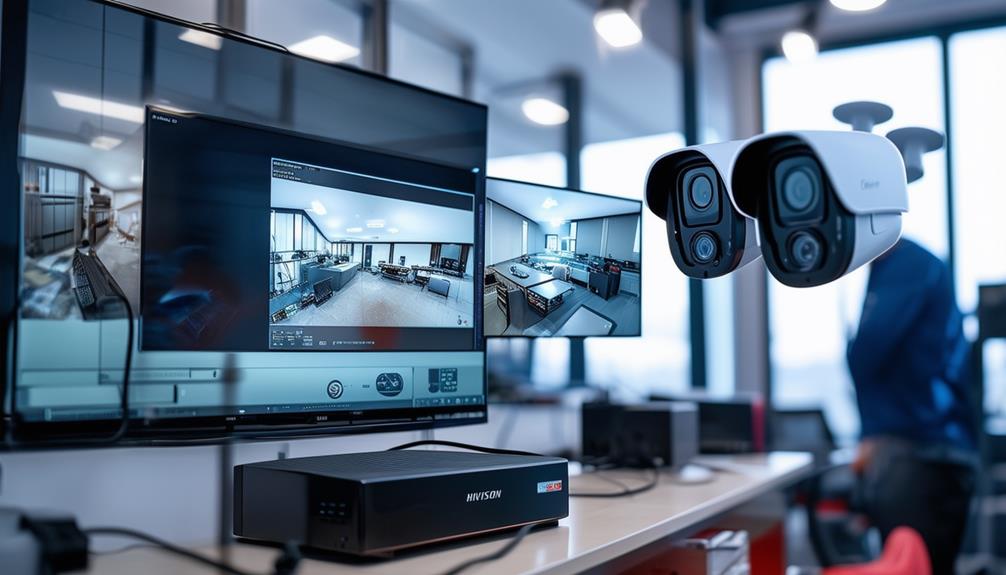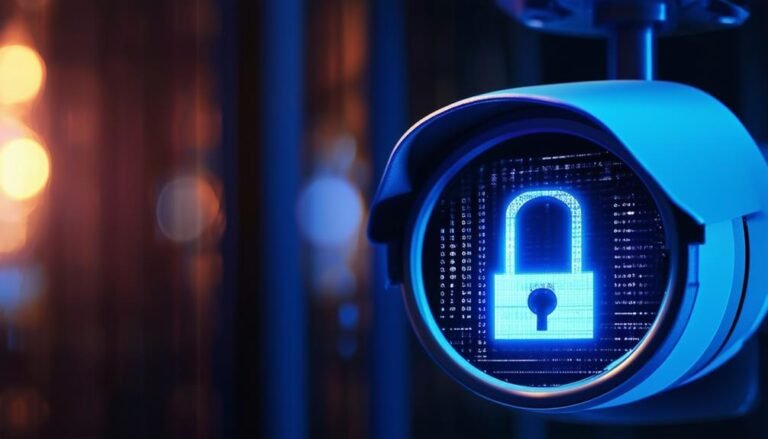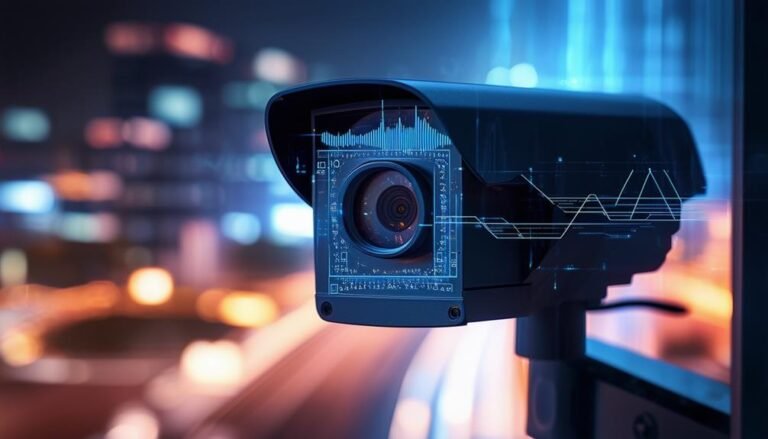To add a Dahua camera to your Hikvision NVR, first verify both devices are on the same network. Access the NVR interface via a web browser using its IP address. Navigate to the “Camera” section and select “Add Camera.” Enter the Dahua camera’s IP address, username, and password. After confirming the addition, check the live feed to verify everything’s working correctly. Adjust camera settings such as resolution and frame rate to suit your surveillance needs. If you run into issues, you’ll find helpful troubleshooting tips that can help you optimize the setup effortlessly.
Understanding Compatibility Issues
When it comes to integrating your Dahua camera with a Hikvision NVR, understanding compatibility issues is crucial for a smooth setup. You want your security system to work seamlessly, and knowing the potential hurdles can save you time and frustration. First off, it’s important to know that Dahua and Hikvision use different protocols for communication. This means not every Dahua camera will effortlessly connect to your Hikvision NVR.
You’ll need to check the specifications of both devices to verify they support common video standards, like ONVIF, which can help bridge the gap between the two brands. It’s a good idea to verify the firmware versions on both devices. Sometimes, updating the firmware can resolve compatibility problems, allowing for better interoperability.
Another factor to keep in mind is the resolution and frame rate of your Dahua camera. If your NVR can’t handle the camera’s specifications, you might run into issues like lag or poor image quality. Always consult the user manuals and compatibility lists provided by both Dahua and Hikvision to make informed choices.
In some cases, using third-party software can help facilitate the connection if you encounter persistent compatibility issues. Remember, the freedom of your security setup hinges on understanding these technical nuances. By preparing adequately, you can enjoy the peace of mind that comes with a fully integrated surveillance system tailored to your needs.
Gathering Necessary Equipment
Before you start adding your Dahua camera to the Hikvision NVR, you’ll need to gather some essential equipment. Make sure you have the right cables and connectors, check that your NVR model is compatible, and confirm the power supply specifications. Having everything ready will streamline the setup process and save you time.
Required Cables and Connectors
To successfully connect your Dahua camera to a Hikvision NVR, you’ll need to gather the right cables and connectors. This step is essential for guaranteeing seamless integration and the freedom to monitor your space the way you want.
Here’s a simple table to help you visualize the vital cables and connectors you’ll need:
| Cable/Connector | Purpose | Emotion |
|---|---|---|
| Ethernet Cable | Connects your camera to the NVR | Empowerment |
| Power Adapter | Supplies power to your camera | Security |
| BNC Connector (if needed) | For coaxial connections (if applicable) | Control |
With these components, you can guarantee that your Dahua camera operates effectively with the Hikvision NVR. It’s all about having the right tools at your fingertips, giving you the freedom to set up your security system just how you envision it. Make sure to double-check the specifications of each cable and connector to avoid compatibility issues. With everything ready, you’re one step closer to achieving the peace of mind that comes from a properly functioning surveillance system.
Compatible NVR Models
It is crucial to guarantee your NVR is compatible with your Dahua camera for a smooth integration. Not all NVRs will work seamlessly with Dahua devices, so you’ll want to do your homework before making any connections. Look for NVR models that support ONVIF protocols, as this will greatly enhance compatibility. Hikvision’s newer models often have this feature, allowing for better communication between the NVR and your Dahua camera.
You should check the specifications of your NVR to confirm it supports the video formats used by Dahua cameras, such as H.264 or H.265. Some Hikvision NVRs come with built-in support for third-party cameras, but it’s wise to verify this in the user manual or manufacturer’s website.
If you’re looking for specific models, consider Hikvision’s DS-7600 series or the DS-8000 series, which generally offer compatibility with various brands. Always verify you have the latest firmware updates for your NVR to avoid any issues. With the right equipment, you’ll find that adding your Dahua camera is a straightforward process, giving you the freedom to set up your security system exactly how you want it.
Power Supply Specifications
Guaranteeing that your Dahua camera operates effectively with your Hikvision NVR involves more than just compatibility; you also need to take into account the power supply specifications. First, check the power requirements of your Dahua camera, typically listed in the user manual. Most Dahua cameras operate on 12V DC, but some models may require PoE (Power over Ethernet). If you’re using PoE, make sure your NVR supports this feature, as it can simplify your setup by eliminating the need for additional power cables.
If your camera needs a separate power supply, you’ll want to select a power adapter that matches the camera’s voltage and current ratings. Using an adapter with a higher voltage can damage your camera, while one with insufficient current may lead to performance issues. Always choose a reliable brand to guarantee the safety and longevity of your devices.
Lastly, consider the distance between your camera and power source. If it’s too far, you might need thicker cables to reduce voltage drop. By paying attention to these power supply specifications, you’ll set the stage for a smooth, hassle-free integration of your Dahua camera into your Hikvision NVR system.
Configuring Dahua Camera Settings
While setting up your Dahua camera, you’ll want to access its settings to confirm peak performance and compatibility with your Hikvision NVR. Start by connecting your camera to the network and using a web browser to enter its IP address. You’ll need to log in with your username and password. Once you’re in, you can adjust various settings to suit your needs.
First, check the video settings. Verify the resolution, frame rate, and bitrate are configured correctly. A higher resolution may provide clearer images but will require more bandwidth. So, if you’re looking for freedom in your network usage, find a balance that works for you.
Next, navigate to the network settings. Make sure your camera is set to a static IP address within the same subnet as your Hikvision NVR. This way, the NVR can easily recognize and communicate with the camera. Don’t forget to configure the RTSP stream, as it’s essential for video transmission.
Another important setting is the motion detection feature. You can customize the sensitivity and areas for detection, allowing for more tailored monitoring. This can help you avoid unnecessary alerts while still keeping an eye on important areas.
Lastly, explore the storage settings to confirm your camera’s recordings are set up properly. You might want to configure the schedule for recordings or set it to record continuously, depending on your surveillance needs. With these configurations, you’ll be all set for seamless integration with your Hikvision NVR.
Accessing Hikvision NVR Interface
Accessing your Hikvision NVR interface is a straightforward process that allows you to manage and monitor your connected devices. To get started, you’ll need to verify your NVR is powered on and connected to your network. Grab your computer or mobile device, and open a web browser.
In the address bar, enter the IP address of your NVR. If you’re unsure what this is, you can usually find it in your network settings or through the NVR’s manual. Press Enter, and you’ll be prompted to log in. Use your username and password; these are often set to defaults like “admin” for both fields, but it’s a good idea to change them for security.
Once you’re logged in, you’ll be greeted by the NVR interface. This will let you navigate through various settings and options. Don’t rush; take your time to explore the menu. You’ll find tabs for live view, playback, and configuration. Each option has its own set of features that can help you customize your surveillance experience.
If you’re using a mobile device, you might consider downloading the Hik-Connect app, which provides a more convenient way to access your NVR. Just enter the same login credentials, and you’ll have a portable view of your system.
Adding Dahua Camera to NVR
To successfully add a Dahua camera to your Hikvision NVR, you’ll need to start by ensuring both devices are connected to the same network. This is vital because, without a proper connection, your NVR won’t recognize the camera. Once you’ve confirmed that, grab your NVR’s interface and navigate to the “Camera” section.
Next, look for an option that says “Add Camera” or “Manual Add.” Here, you’ll need to input the Dahua camera’s details. This typically includes the camera’s IP address, which you can find in the camera’s settings or through your network management interface. Make sure to enter the correct username and password for the camera, as this is important for establishing a successful connection.
After entering all the necessary information, hit the “Add” or “OK” button. Your NVR will attempt to connect to the Dahua camera. If everything’s set up correctly, you should see a confirmation message indicating the camera has been successfully added. If you encounter any issues, double-check the IP address and credentials you entered.
Lastly, give yourself the freedom to explore the NVR’s interface. Familiarize yourself with the features available for viewing or recording from the new camera. You’ve taken a significant step in expanding your surveillance capabilities, and now it’s time to enjoy the peace of mind that comes with it. Your Dahua camera is now part of your Hikvision setup!
Adjusting Camera Settings
Adjusting camera settings is vital for optimizing your surveillance system’s performance. It’s not just about having cameras; it’s about making certain they work effectively for your unique needs. You’ll want to tailor the settings to capture the best possible footage, guaranteeing you don’t miss anything important. Here are three significant adjustments to take into account:
- Resolution: Set your camera to the highest resolution that your NVR can handle. Higher resolution provides clearer images, making it easier to identify faces and details.
- Frame Rate: Adjust the frame rate according to your environment. In areas with high movement, a higher frame rate can help capture smoother video. Conversely, for quieter areas, you can lower the frame rate to save storage space.
- Field of View (FOV): Verify your camera’s FOV is correctly configured to cover the desired area. You might need to tilt or pan your camera to maximize its coverage, eliminating blind spots.
These adjustments aren’t just technical tweaks; they’re about reclaiming your peace of mind. A well-configured camera system empowers you to monitor your property effectively, guaranteeing you feel secure and in control. Remember, freedom comes when you know you’ve done everything you can to protect what matters. So take the time to fine-tune your camera settings, and you’ll reap the benefits of a surveillance system that truly works for you.
Testing Camera Feed
Testing the camera feed is essential to verify that your Dahua camera is properly integrated with your Hikvision NVR. Once you’ve adjusted the settings, it’s time to check if everything’s functioning as it should. Start by accessing your NVR’s interface through a web browser or the dedicated software. If you’ve done it right, your Dahua camera should appear on the dashboard.
Next, click on the camera feed to see if the live view displays correctly. You’ll want to confirm that the image quality meets your expectations—clear, bright, and free from distortion. If the feed isn’t coming through, don’t panic. It’s all part of the process.
Check the connection; make sure the cables are snug and that the camera is powered on. If you’re using Wi-Fi, verify that your camera is within range of your router. You might also want to check that the camera is set to the correct channel and that there are no interference issues.
When the feed is live, take a moment to walk around the area covered by the camera. This’ll help you see if the motion detection is working correctly and if the camera captures all the necessary angles. Don’t forget to test the audio if your camera has it!
Once you’re satisfied with the camera feed, you can confidently proceed, knowing your system is set up for ideal surveillance. Enjoy the peace of mind that comes with knowing you’ve got your bases covered!
Troubleshooting Common Problems
If you’re facing issues with your Dahua camera connecting to your Hikvision NVR, it’s important to check a few key factors. You’ll want to guarantee compatibility between the devices and that both have the latest firmware updates. Let’s explore common problems and how to resolve them effectively.
Connection Issues
Connection issues can be frustrating, especially when you’re trying to integrate a Dahua camera with a Hikvision NVR. You want your surveillance system to work seamlessly, but sometimes things don’t go as planned. Here’s a quick guide to help you troubleshoot common connection problems.
- Check Network Configuration: Confirm that both devices are on the same network. A simple IP address conflict can prevent them from communicating. Verify their settings to confirm they’re compatible.
- Firewall & Security Settings: Firewalls or security settings can block the connection. Make sure that your network allows traffic between the Dahua camera and Hikvision NVR. You might need to adjust your router settings to enable proper access.
- Firmware Updates: Outdated firmware can lead to connection issues. Check if both your camera and NVR are running the latest firmware versions. If not, update them to improve compatibility and stability.
Compatibility Checks
After addressing connection issues, it’s important to confirm that your Dahua camera is compatible with your Hikvision NVR. Compatibility checks can save you time and frustration when setting up your system. Here’s a quick guide to help you identify key factors that guarantee your devices work harmoniously.
| Feature | Dahua Camera | Hikvision NVR |
|---|---|---|
| Protocol | ONVIF | ONVIF |
| Resolution Support | 1080p, 4MP, 4K | 1080p, 4MP |
| Network Type | Ethernet, Wi-Fi | Ethernet |
| Firmware Compatibility | Latest version required | Latest version required |
| Supported Video Formats | H.264, H.265 | H.264, H.265 |
Before you engage in the setup, confirm both your camera and NVR are running compatible protocols and support the same resolutions. If there are discrepancies, you might face issues streaming or recording footage. Always check the manual or specifications for both devices, and remember, a little preparation goes a long way in achieving smooth integration and functionality.
Firmware Updates
Keeping your Dahua camera and Hikvision NVR updated with the latest firmware is essential for avoiding common issues and ensuring the best performance. Outdated firmware can lead to compatibility problems, security vulnerabilities, and reduced functionality. To keep your system running smoothly, follow these key steps:
- Check for Updates Regularly: Set a reminder to check for firmware updates every few months. Manufacturers often release updates to fix bugs and enhance features.
- Backup Your Settings: Before updating, make sure to backup your current settings. This way, if something goes wrong during the update, you can quickly restore your system to its previous state.
- Follow Update Instructions Carefully: Each firmware update will come with specific instructions. Read them thoroughly and follow them step by step to avoid mishaps that could disrupt your camera’s performance.
Optimizing System Performance
When you’re integrating a Dahua camera with a Hikvision NVR, maximizing system performance is essential for guaranteeing smooth operation and high-quality video feed. To achieve this, start by checking your network bandwidth. Since both devices rely on a stable connection, you want to verify your network can handle the data traffic. Consider setting up a dedicated network for your surveillance system to avoid interference from other devices.
Next, configure your camera settings. You might want to adjust the resolution and frame rate according to your needs. While higher settings provide better clarity, they also demand more bandwidth. Strike a balance that meets your surveillance requirements without overloading your system.
In addition, regularly monitor your NVR’s storage capacity. If it’s nearing full capacity, it can affect performance. Set up automatic overwriting or regularly back up and clear old footage to keep your system running smoothly.
Don’t forget about software updates! Keeping your NVR firmware and camera software up to date can enhance compatibility and performance. Check for updates periodically to take advantage of enhancements and security patches.
Lastly, consider the placement of your cameras. Verify they’re positioned for maximum coverage while avoiding obstructions that might interfere with the signal. With these steps, you’ll enhance the performance of your Dahua camera and Hikvision NVR setup, allowing you to enjoy the freedom of reliable surveillance.
Maintaining Your Surveillance System
To guarantee your Dahua camera and Hikvision NVR continue to operate effectively, regular maintenance is key. Just like any technology, these devices need your attention to make certain they deliver the security you desire. You don’t want to miss any vital moments due to a malfunction, right? Here are three essential maintenance tasks you should incorporate into your routine:
- Check Connections: Regularly inspect all physical connections, including cables and ports. Make sure everything is secure and free from damage. Loose or frayed wires can lead to connectivity issues that compromise your surveillance.
- Update Firmware: Keeping your devices updated is essential. Manufacturers release firmware updates to fix bugs and enhance security. Check for updates for both your Dahua camera and Hikvision NVR, and apply them as needed. This simple step can dramatically improve performance and security.
- Clean the Cameras: Dust, dirt, and grime can obstruct your cameras’ lenses, which impacts image quality. Every few months, gently clean the lenses with a soft cloth designed for optics. Avoid harsh chemicals that could harm the camera.
Frequently Asked Questions
Can I Add Multiple Dahua Cameras to One Hikvision NVR?
Can you imagine the flexibility of adding multiple cameras to one NVR? Yes, you can integrate several Dahua cameras into a Hikvision NVR, but it’s essential to guarantee compatibility. You’ll need to check if the NVR supports the specific protocols used by your Dahua cameras. Once you confirm that, you’ll enjoy the freedom to monitor multiple angles seamlessly. Just remember, proper configuration is key to achieving the best results!
What Are the Benefits of Using Dahua Cameras With Hikvision NVRS?
Using Dahua cameras with Hikvision NVRs offers you flexibility and choice. You get high-quality video surveillance without being locked into one brand. This combination can enhance your system’s capabilities, allowing you to customize features to suit your needs. Plus, you can often find cost-effective options without sacrificing performance. With the right setup, you’ll enjoy greater control over your security, making it easier to monitor your property effectively.
Is There a Specific Firmware Required for Compatibility?
When it comes to compatibility, you might find that specific firmware versions are essential. It’s best to check the latest updates for both your Dahua camera and Hikvision NVR. Sometimes, using the latest firmware guarantees better integration and functionality. Don’t forget to explore user forums or the manufacturers’ websites for guidance. Verifying both devices are up-to-date can save you a lot of hassle and help you achieve that seamless experience you’re looking for.
Will Adding a Dahua Camera Void My Hikvision Warranty?
Adding a Dahua camera to your Hikvision system might raise concerns about warranty implications. Generally, mixing brands could lead to complications, but it doesn’t automatically void your warranty. Still, it’s wise to check the specific terms of your warranty agreement. If it allows for third-party integrations, you’re likely in the clear. Always remember, staying informed about your equipment’s policies empowers you to make choices without feeling restricted.
Can I Integrate Other Brands of Cameras With My Hikvision NVR?
Yes, you can integrate other brands of cameras with your Hikvision NVR, but there are some caveats. You’ll need to verify the cameras support the same protocols, like ONVIF, for smooth communication. While it offers flexibility, mixing brands can sometimes lead to compatibility issues. So, if you’re looking for freedom in your setup, just double-check compatibility before making any purchases to avoid future headaches.



